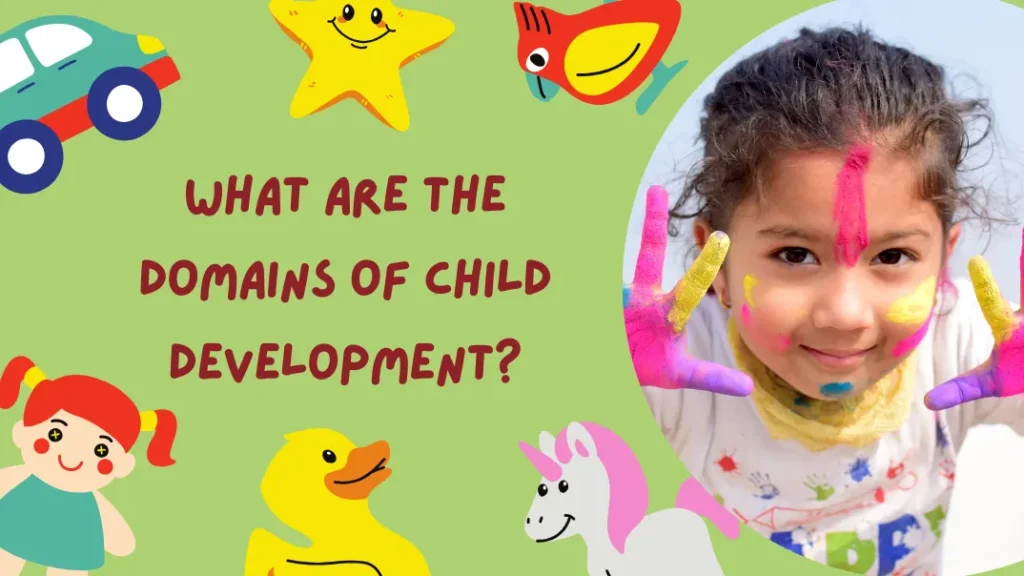Whether you’re a preschool teacher working with toddlers, or a parent looking to better understand your child’s development, grasping the essential domains of child development can equip you with the knowledge to nurture a child’s growth in a balanced and effective way. These domains cover everything from physical strength to emotional intelligence, from language skills to problem-solving abilities, each contributing to a well-rounded individual.
Domains of child development unfolds across several domains, including physical, cognitive, social-emotional, language, and adaptive skills. Each domain contributes uniquely to a child’s overall growth. Understanding these domains of child development allows parents and caregivers to identify developmental milestones and address potential delays early, ensuring children grow into confident, well-adjusted individuals.
What Is Child Development?
Child development is the process by which children grow and mature, acquiring the skills needed to navigate life. It covers four primary areas: physical, cognitive, social-emotional, and language development. The physical domain of development focuses on the growth of the body and motor skills. Cognitive development relates to mental abilities such as learning, memory, and problem-solving. The social domain of development involves the ability to understand and manage emotions, form relationships, and engage with others. Language development includes the acquisition of verbal and non-verbal communication skills. These domains of child development are interconnected, meaning that progress in one area can often lead to progress in others. Healthy development in these four areas is vital for a child’s ability to succeed academically, socially, and emotionally.
Domains of Child Development: The Four Pillars of Growth
The primary domains of child development provide a structured way to understand a child’s overall growth. Each domain reflects a different child development, but they are interrelated and affect each other in significant ways.

1. Physical Domain Development
The physical domain of child development refers to the bodily growth and motor skill progression in children. It includes changes in the brain, muscles, bones, and sensory systems, and has a direct impact on how children engage with their environment.
Motor Skills Development
In infancy and early childhood, a child’s gross motor skills (such as crawling, walking, and jumping) develop first. These skills require large muscle groups and help children explore their environment. Fine motor skills, such as the ability to grasp small objects or feed themselves, develop later, as children’s hands and fingers gain more control.
The development of motor skills is a major milestone in early childhood, impacting a child’s ability to engage in physical activities like sports, play, and everyday tasks such as writing. By age three, many children can run, climb, and engage in activities like stacking blocks, while by age five, they can often ride a bike or tie their shoes.
Growth Milestones
Physical domain development involves dramatic changes, especially in the first few years of life. Infants typically double their birth weight by about six months, and by the age of one, they have tripled it. Over the course of the first five years, children experience rapid increases in height and weight, with significant changes in their skeletal and muscle structure.
By the time children reach school age, their growth slows down a little, but their bodies continue to grow at a steady pace until puberty. Puberty, typically starting between ages 8 and 14, brings with it a growth spurt and the development of secondary sexual characteristics, signaling the transition from childhood to adolescence.
Factors Affecting Physical Development
Nutrition, genetics, and environment are key factors that influence physical domain development. Proper nutrition is essential for bone, muscle, and brain development. Lack of adequate nutrition can lead to growth delays, which may, in turn, affect cognitive and social development. Genetics also plays a role in determining a child’s physical characteristics, including their size and potential for athleticism. Environmental factors, such as exposure to toxins or a sedentary lifestyle, can slow physical domain development or lead to health complications.

2. Domains of Child Development: Cognitive Development
Cognitive domain of development refers to the growth of mental abilities such as learning, memory, problem-solving, and reasoning. It’s through this domain that children learn how to understand and interpret the world around them, and as they grow, their thinking becomes more complex and abstract.
Stages of Cognitive Development
According to developmental psychologist Jean Piaget, cognitive development happens in four stages:
- Sensorimotor Stage (0-2 years): Babies learn through their senses and physical interactions with the world around them. Object permanence, or the understanding that objects exist even when out of sight, is a key milestone.
- Preoperational Stage (2-7 years): Young children begin to use symbols (like words and images) to represent objects and events. However, their thinking is still very concrete, and they often struggle with logic and perspective-taking.
- Concrete Operational Stage (7-12 years): Children start to develop logical thinking, understanding concepts like conservation (the idea that quantity remains the same despite changes in shape or appearance).
- Formal Operational Stage (12+ years): Adolescents can think abstractly and hypothetically. They start considering future possibilities and engaging in more complex problem-solving.
Don’t just dream it, design it! Let’s chat about your custom furniture needs!
Language and Communication Development
Cognitive domain development is closely tied to the development of language skills. From the moment they are born, infants begin learning the basics of communication—first through crying, and then through babbling, cooing, and eventually speaking words. By the time children reach 2-3 years old, they can usually form short sentences, and by age five, many can speak fluently and use complex sentences.
Language acquisition plays a key role in cognitive domain of development. A child’s vocabulary and ability to use language will significantly impact their cognitive abilities, including reasoning, problem-solving, and academic success later in life.
Educational Influences on Cognitive Development
School and formal education are crucial for enhancing cognitive domain development. As children grow older, they acquire knowledge in subjects like math, science, history, and language, which provides them with the skills they need to think critically and solve problems. The quality of education and the environment in which a child learns can greatly influence their cognitive domain development.

3. Domains of Child Development: Emotional Development
Emotional domain of development refers to the ability of children to understand, express, and regulate their emotions. It is through this domain that children begin to develop emotional intelligence—learning how to recognize emotions, empathize with others, and manage feelings appropriately.
Early Emotional Milestones
From infancy, babies begin to express basic emotions like happiness, sadness, and anger. They rely heavily on their caregivers for emotional support and guidance. Over time, as children grow, they start to identify and label their emotions, and they begin to understand that others have emotions too. By the age of two, children may express frustration, empathy, and joy in socially appropriate ways.
Emotional Regulation and Coping Skills
As children grow, they develop the ability to regulate their emotions. In the early years, a child may not know how to calm down when upset. With time, children start to learn strategies such as deep breathing, talking about their feelings, or asking for help when they feel overwhelmed. By the time children enter school, they should be able to manage emotions like frustration, anger, and anxiety in socially acceptable ways.

4. Domains of Child Development: Social Development
Social domain of development refers to the growth of a child’s ability to interact with others and form relationships. Social development is crucial for building friendships, understanding societal norms, and learning to collaborate with peers.
Building Social Skills
From birth, babies begin to engage with others through eye contact, smiling, and cooing. As children grow, they become increasingly engaged in social interactions. By preschool, children start to play with other children in parallel play and, later, cooperative play, which helps them understand important social concepts such as sharing, turn-taking, and conflict resolution.
Don’t just dream it, design it! Let’s chat about your custom furniture needs!
Peer Relationships and Social Identity
As children enter school, peer relationships become a dominant factor in their social development. They start to form lasting friendships and develop a sense of belonging. Adolescents, in particular, place significant importance on social identity, often experimenting with different social groups to find their place in the world.
Stages of Child Development
Child development occurs in stages, with each stage marked by specific physical, cognitive, and emotional milestones. These stages serve as a guide to understanding a child’s progress and provide a framework for addressing developmental concerns.

- Infancy (0-2 years)
The infant stage is one of rapid growth and change. During this time, babies develop basic motor skills, such as holding their head up, sitting, crawling, and eventually walking. Their language skills also begin to emerge, with their first words typically occurring around the age of one. Cognitively, infants begin to explore their environment through sensory experiences, forming the foundation for later problem-solving and critical thinking. - Early Childhood (2-6 years)
Early childhood is marked by increasing independence and the development of more refined motor and cognitive skills. Children engage in imaginative play with different toys, which enhances creativity and problem-solving skills. Language skills rapidly expand, allowing children to communicate more effectively and begin developing a sense of self. Socially, children start forming relationships with peers and learning social rules, such as sharing and taking turns. - Middle Childhood (6-12 years)
During middle childhood, children refine their motor skills, cognitive abilities, and social relationships. They begin to understand more complex concepts, like time and money, and improve their academic skills. Peer relationships become more important, and children often seek approval from friends and classmates. Emotionally, children begin to understand their own feelings and those of others, leading to increased empathy and better conflict-resolution skills. - Adolescence (12+ years)
Adolescence is a time of intense emotional and physical change. Puberty brings about significant physical changes, including growth spurts and the development of secondary sexual characteristics. Cognitively, adolescents begin to think more abstractly, considering complex ideas and moral dilemmas. They begin to form their own identities and become more influenced by peer groups. Socially and emotionally, adolescence can be a turbulent time, but it is also a period of tremendous growth and self-discovery.
Factors Affecting Child Development
Child development is influenced by a wide variety of factors that include genetics, the environment, nutrition, and societal influences. The domains of development are shaped by the interplay of both nature (genetics) and nurture (environment), and each factor plays a unique role in shaping the developmental trajectory of children.
Genetics and Heredity
Genetics is a fundamental factor in the domains of child development. A child inherits certain traits and characteristics from their parents, such as temperament, intelligence, and even physical traits like height or predispositions to certain health conditions. These genetic influences set a baseline for development, but environmental factors can modify or enhance these genetic potentials.
The Role of Nutrition
Adequate nutrition is one of the most important factors influencing a child’s physical domain development. In the early years, a child’s brain and body are rapidly growing, and proper nutrients are critical for supporting both motor skills development and brain functions like memory, attention, and problem-solving. A deficiency in key nutrients such as iron or calcium can lead to developmental delays in the physical and cognitive domains.
The Impact of the Home Environment
The home environment is another significant factor that shapes child development domains, especially during the first few years of life. A supportive and loving home environment helps foster a child’s emotional well-being, cognitive development, and social skills. For example, caregivers who engage in frequent communication, reading, and play with children lay the foundation for healthy language development and cognitive skills.
A lack of emotional support or exposure to neglect or abuse can cause significant setbacks in a child’s emotional domain of development and even in physical domain development. Early childhood domains of development are particularly sensitive to the presence of a stable, nurturing home environment, which helps promote the healthy growth of both body and mind.

Parenting Styles
The way a parent interacts with their child can also have a profound impact on the various domains of child development. Research shows that the parenting style—whether it is authoritative, authoritarian, permissive, or neglectful—affects how children interact with their peers and their ability to regulate their emotions.
- Authoritative parenting—characterized by warmth, responsiveness, and firm boundaries—has been found to be the most effective style for promoting balanced social-emotional development. Children raised with this style tend to have better self-esteem, higher academic performance, and healthier social relationships.
- Authoritarian parenting, which is more rigid and controlling, often leads to children who are less socially competent and more likely to experience anxiety or depression. Emotional domain development can be stunted under this style due to a lack of emotional support and open communication.
- Permissive parenting, while warm and accepting, may lead to children who struggle with self-discipline and boundaries, which impacts both their social domain of development and cognitive domain development as they may lack the skills needed to navigate structured environments like school.
- Neglectful parenting can have the most harmful effects, leading to a lack of emotional regulation, stunted physical development, and challenges in all domains of child development, including social and cognitive growth.
Cultural and Societal Influence
Children’s development domains are also significantly shaped by the culture and society in which they are raised. Cultural norms, expectations, and the community’s emphasis on education, social interaction, and moral values can influence how children grow and learn.
- Social domain of development is often influenced by cultural expectations for behavior and emotional expression. For instance, in some cultures, children are taught to express emotions openly, while in others, emotional restraint is emphasized.
- The cognitive domain of development can also be impacted by the educational system and the value placed on learning within a particular culture. For example, children in cultures that prioritize high academic achievement may experience a faster pace in their cognitive development domains, particularly in language development and problem-solving abilities.
- The concept of adaptive domain of development is also related to how children learn to adapt to their cultural environment, balancing societal expectations with personal growth and autonomy.
Don’t just dream it, design it! Let’s chat about your custom furniture needs!
FAQs
- What are the main domains of child development?
The four primary domains of child development are physical development, cognitive development, emotional development, and social development. - How does cognitive development impact a child’s future?
Cognitive domain development shapes a child’s ability to learn, solve problems, and think critically, which are essential skills for success in school and life. - What is the role of emotional development in child growth?
Emotional domain of development helps children regulate their emotions, understand their feelings, and build strong, healthy relationships. - How can parents support their child’s social development?
Parents can support social domain of development by encouraging playdates, teaching social skills, and providing opportunities for their child to interact with peers. - Is early intervention important in child development?
Yes, early intervention is crucial in addressing developmental delays and ensuring that children receive the support they need to thrive. - How are the domains of child development interconnected?
The domains of child development are interconnected in that they influence each other. For example, physical health impacts cognitive development, and emotional regulation affects social interactions.
Conclusion
In conclusion, child development is a multifaceted process that includes several essential domains of development: physical, cognitive, social-emotional, and language development. Each domain is interconnected, influencing the others as children grow. The definition of domains of development encapsulates the idea that all these areas work together to help a child become a well-rounded individual capable of thriving in various life situations.
By understanding the intricacies of the domains of child development, caregivers, educators, and parents can make informed decisions about how to support each child’s growth, ensuring that they reach their full potential. Whether it’s through fostering a stimulating environment, offering opportunities for play, or encouraging healthy relationships, each step taken towards nurturing these development domains makes a lasting difference in a child’s life.



